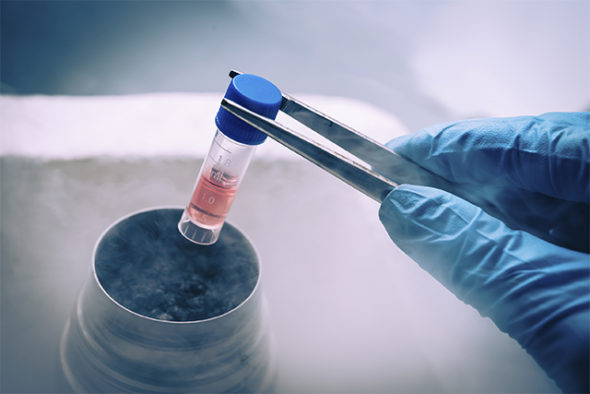Rachel Winston, a fertility expert and mom on the front lines of IVF treatment, shares what every woman needs to know about frozen embryo transfers.
So you’ve gone through the process of freezing your eggs (or even freezing your embryos), or you finished your IVF and have some frozen little guys left over and want to give them a chance at babyhood — or maybe you’re hedging your bets and praying for the best. This is the frozen embryo transfer (FET) checklist for you need to read and take note of before heading back to the doc. I wish I had this (or frankly, some more experienced person to guide me) before starting my frozen embryo transfers as it would have saved me time, frustration, and money. As any woman or couple going through almost any type of fertility treatment will tell you, emotions and dollar signs are already running high. A FET cycle costs around $3,500-$4,500 in the USA, plus additional medication which runs $1,200-$2,000 depending on what your doc has you on and your insurance is willing to cover (or not).
READ MORE: How to choose the right doctor for your IVF/egg freezing
Frozen embryo transfers are when your existing frozen embryos are literally defrosted and implanted into your uterus. The goal, obviously, is to make a baby or babies from the transfer. If you froze your eggs, you’re exactly the kind of girl who can expect to hear a doctor suggest a frozen embryo transfer — but you should know that you’re signing up for additional hurdle rates (including just in the defrosting process), and gambling in higher risk ways on just how successful the fertilization of your eggs might be (forget about growing successful embryos into babies and beyond for now).
Please bookmark this article and print it out before you speak to your doctor about doing your FET.
Here are some things to ask for before you do your FET to insure that you have maximum success:
1. Ask for an ERA biopsy test. It’s a must.
I recommend that you ask to do an ERA test before you do any transfers. This is a test that checks the exact time to do the transfer on a molecular level. Imagine that, getting to the molecular level of your uterine tissue… but that’s exactly where you need to be when time, money, and emotional energy is running in short supply. The typical recommendation is to try the ERA test after 3 failed FETs. It costs about $1,000 so it isn’t recommended for average patients unless they experience repeated transfer failures. About 25% of frozen embryo transfer fails are actually due to simple miscalculations in transfer timing. Because your embryos are so precious (and expensive), I recommend insisting on this test before transferring anything. It could actually save money and heartache in the long haul.
The process leading up to the ERA test is fairly simple (cost aside). You continue taking your medication as though you’re doing an FET (estrogen for 3 weeks, progesterone for 5 days) and then your doctor will perform a uterine biopsy for the test. It feels similar to a PAP smear and is typically not painful. Here’s some more info on what to expect.
2. Acupuncture before and after transfer… and maybe a little something to take the edge off.
Did you know acupuncture is actually proven to raise implantation rates as high 20-30% depending on the study? Relaxation is hugely important in an embryo transfer — mom’s health start and end in just her physical body. The pursuit of fertility is very much an emotional one as well. Acupuncture has the ability to enable your doctor to get through your cervix easier and makes your body more receptive to the embryo. Some doctors also actually suggest 5-10mg of Valium about 1/2 hour before the procedure to help you relax and allow the cervix muscles to calm down. Others will ask you to take a slight pain receiver to help you relax (Advil/ Tylenol).
READ MORE: Secondary Infertility Vitamins (what you need to know)
3. Do not do a natural cycle frozen embryo transfer.
Some studies I’ve read have show that transfers done with preparation before FET have 30-40% higher success rates. I like those odds. Preparation means hormones before the transfer itself, including estrogren for 3 weeks and progesterone for 5 days. You also continue medications until after a pregnancy test and if it’s positive, for the first 8-10 weeks of pregnancy. Some doctors like to do a cycle of Lupron priming before which is down regulated for a month, and then start followed by estrogen with Lupron before progesterone.
Some doctors like to also use steroids (prednisone) during the transfer, however new studies suggest that steroids do not increase live birth rates at all. My doctor doesn’t like to use steroids because of the associated reactions (mood swings, weight gain, bloating etc) and he says there is no evidence that it increases implantation or live birth rates. Some doctors prefer to give a shot of HCG. While there is no research that suggests it helps, there is apparently no down side either (according to the doctors I’ve spoken with). There might be a placebo effect, which can be positive.
4. Uterine scratching before your frozen embryo transfer.
Sounds a little gnarly, right? Who wants to be scratched? It’s not as bad as it sounds, and it’s basically similar to the experience and feeling of a biopsy, but the intention is to make a tiny indentation in your uterus for the embryo to bury itself in and create a new home. There’s some research to support that it actually increases implantation rates by as much as 30%. It can’t hurt (your chances, maybe it’ll bother you a little physically) so I recommend it.
5. Vitamins and folic acid before your FET to get ready for pregnancy.
If your doc suggests it, do it. Prepping your body will be good physically, but also mentally in case you’re a worry wart. These are high quality, affordable, and recommended.
6. Drink water before the FET procedure, but not too much.
Many doctors want you to have a full or semi full bladder so they can easily access the cervix, especially if you have never had kids before, or if you have a weird-shaped cervix. Many times the doctor has never gone and checked out your cervix before, so a full bladder helps him explore this ‘virgin’ territory. The doctor will take a catheter with the defrosted embryo and insert it into your vagina, go up through the cervix and into your uterus. He or she should do this with an ultrasound guided scope (make sure before) — you don’t want someone going in there blindly (this probably applies to everything in life though, right?).
So with a full bladder you’ll feel like you have to pee the whole time, isn’t that a lovely pre-pregnancy preparation for actual pregnancy? It’s not the most comfortable thing and you have to wait in a stationary legs-up position for 15-20 minutes after the procedure. Ask your doctor to check out your cervix before and see how full (if at all) he wants your bladder before the procedure. You’ll never be embarrassed to ask for anything extra at a restaurant again, because after you ask your doctor to check your cervix and bladder, you’re basically set for life in terms of openness.
The hurdle rates for frozen embryo transfer are the following:
1. Frozen embryos need to thaw in tact, and 95-98% of the time everything is okay.
Around 5% of the time the embryo doesn’t make it through the thawing process.
2. They have to time the transfer according to the day the embryo froze.
This means you need to double check the actual embryo they are transferring is the correct day – day 3, or 5 or day 6. It matters. If they freeze the embryo on day 5, you will need to transfer on day 5 with 5 days of progesterone- for example. See? This is where paying attention in math class as a kid actually pays off.
3. Poor timing accounts for 25% of failures.
So getting the ERA test helps overcome this often-disappointing hurdle.
4. The embryo has to actually implant into your uterus (27-30% of the time it is a successful implant).
It is a statistical favorite that implantation will not happen (ugh, science). Don’t get upset (easier said than felt). You will probably have to do this several times. This is why some doctors like to implant 2 embryos at once.
5. You’ll do a 2 week pregnancy test and follow up test.
With a frozen embryo transfer with no HCG hormone before, you can take a blood test after 8-9 days and have an initial result (of a 5-6 day embryo transfer) If there is an HCG test, the wait is 2 weeks so the beta reading isn’t a false positive. Always stay on your medication and wait for a second blood test 2-3 days later to confirm results. If there are any traces of HCG hormone that means there has been a successful implantation, but for you to actually be pregnant the beta levels have to rise significantly after the first test. If not, no pregnancy.
6. With a PGD good embryo (preimplantation genetic diagnosis—genetically tested before) after a successful positive pregnancy test/implantation, there is an 87% chance of a successful live birth (baby!) that’s very good!
Many doctors blend these hurdle rate statistics and say there’s a 50-60% chance of live birth with a good PGD embryo, but if you understand statistics and math, that is simply not the case. Because you have to get past the aforementioned hurdle rates first.
If you’re wondering what that all means:
“Preimplantation genetic diagnosis (PGD) is a screening test used to determine if genetic or chromosomal disorders are present in embryos produced through in vitro fertilization (IVF).”
So that’s my quick outline of the frozen embryo transfer process and my personal experiences with it. Keep this checklist for your records and make sure to ask your doctor all the little things before your start or if you are considering finding the right reproductive endocrinologist. It can’t hurt to save time, energy, money when you’re aiming for optimal fertility.
Love this article? For more beauty, style, travel, and trending topics check out The Luxury Spot on Facebook. Like us and we’ll love you back!










